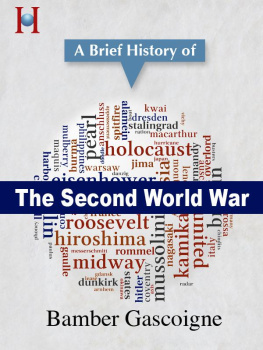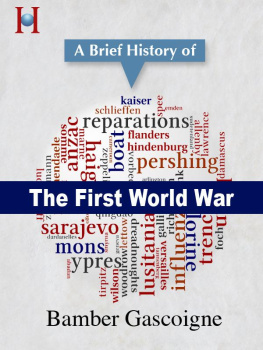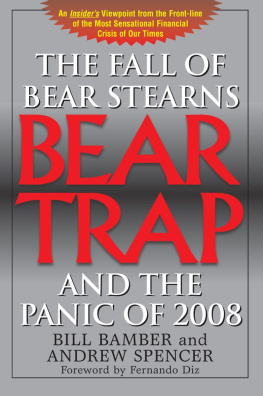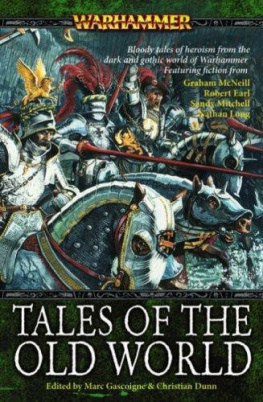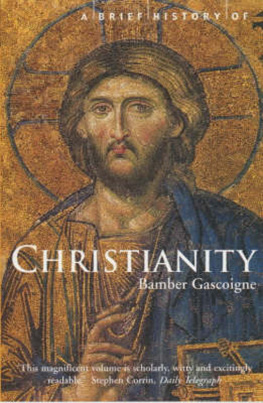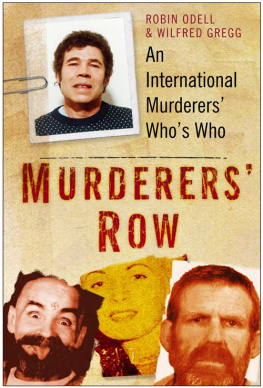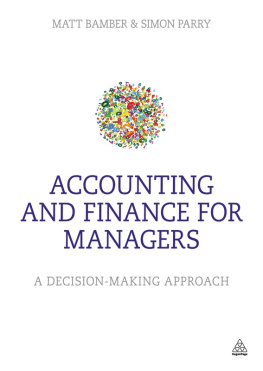Bamber Gascoigne - A Brief History of the Second World War
Here you can read online Bamber Gascoigne - A Brief History of the Second World War full text of the book (entire story) in english for free. Download pdf and epub, get meaning, cover and reviews about this ebook. year: 2010, publisher: HistoryWorld Ltd, genre: Non-fiction. Description of the work, (preface) as well as reviews are available. Best literature library LitArk.com created for fans of good reading and offers a wide selection of genres:
Romance novel
Science fiction
Adventure
Detective
Science
History
Home and family
Prose
Art
Politics
Computer
Non-fiction
Religion
Business
Children
Humor
Choose a favorite category and find really read worthwhile books. Enjoy immersion in the world of imagination, feel the emotions of the characters or learn something new for yourself, make an fascinating discovery.
- Book:A Brief History of the Second World War
- Author:
- Publisher:HistoryWorld Ltd
- Genre:
- Year:2010
- Rating:4 / 5
- Favourites:Add to favourites
- Your mark:
- 80
- 1
- 2
- 3
- 4
- 5
A Brief History of the Second World War: summary, description and annotation
We offer to read an annotation, description, summary or preface (depends on what the author of the book "A Brief History of the Second World War" wrote himself). If you haven't found the necessary information about the book — write in the comments, we will try to find it.
A Brief History of the Second World War — read online for free the complete book (whole text) full work
Below is the text of the book, divided by pages. System saving the place of the last page read, allows you to conveniently read the book "A Brief History of the Second World War" online for free, without having to search again every time where you left off. Put a bookmark, and you can go to the page where you finished reading at any time.
Font size:
Interval:
Bookmark:
HistoryWorld's Pocket History Series No. 1
A Brief History of the
Second World War
Bamber Gascoigne

HISTORYWORLD
Published by HistoryWorld Ltd
1 St Helena Terrace, Richmond,
TW9 1NR, United Kingdom
www.historyworld.net
First published 2010
Copyright Bamber Gascoigne 2010
The moral right of the author has been asserted
All rights reserved
Without limiting the rights under copyright reserved above, no part of this publication may be reproduced, stored in or introduced into a retrieval system, or transmittted, in any form or by any means (electronic, mechanical, photocopying, recording or otherwise), without the prior written permission of both the copyright owner and the above publisher of this book.
ISBN: 978-1-908143-00-6
The series
HistoryWorld's Pocket History series aims to provide short, clear narrative accounts of important themes in world history. Each book consists of the history itself followed by a detailed timeline of the subject and an index. Together they provide a quick and reliable overview of the subject for anyone, from student of any age to pensioner, who wants to discover what happened and when and why.
This account of the Second World War begins with the rise to power of Hitler and the years of confrontation and appeasement which finally led to war when he invaded Poland in 1939. It continues through the six years of the conflict, with its moments of extreme danger and crucial turning points, as the battles by land, sea and air, and the bombing of cities, and the unprecedented hidden horrors of the Holocaust unfold. And it ends with the all too rapid change of gear into the Cold War.
The author
Bamber Gascoigne is best known in the UK as the host for twenty-five years (1962-87) of the popular quiz game University Challenge , the British version of College Bowl in the United States. But his main activity has been bringing general history to a wide public, as the author of books and the author-presenter of television documentaries. In recent years this theme has been continued in the digital medium, first in his involvement with HistoryWorld (www.historyworld.net), a website that he founded and launched in 2001, and now through this series of e-books published by HistoryWorld..
Contents
The approach of war
1939-1941
1941-1942
1941-1943
1942-1943
Hitler's Europe
1944-1945
After the War
The approach of war
A renewal of hostilities
It is a commonplace that the war beginning in 1939 was a continuation of the one which ended in 1918, much as European conflicts of the 18th century (such as the Seven Years' War in 1756) were often a return to unfinished business. In many respects the commonplace is true, and it is reflected in everyday vocabulary. No other wars are numbered I and II, like kings in a line of succession or blockbuster films in a series. The idea of a progression from World War I to World War II is unavoidable, and several factors make it so.
The same nation, Germany, was the participant most actively responsible for each of the two wars. In 1914 this had been a panic reaction, through fear of losing advantage if not moving first. In 1939 it was the deliberate result of the policy of one man, Adolf Hitler. That policy can in many respects be traced back to the after-effects of World War I. Hitler shared a conviction fairly common in Germany, that the nation was not really defeated at the end of that war. Her politicians had capitulated before a single foreign soldier had trodden on German soil. If the match were replayed, the result would surely be different. And in his expansionist plans for Germany, Hitler was able to play on a widespread resentment at the terms and reparations imposed by the Treaty of Versailles.
The peace conference which convened at Versailles in January 1919 had been the concluding chapter of the First World War. It began in Utopian mood. The first decision taken was to found the League of Nations, with its aim of ensuring future peace. But a few months later, when the treaty was signed in June, there was a more vindictive tone in the harsh terms imposed upon Germany. It was decided that her land and sea forces were to be permanently reduced to a very limited size, and that she would be allowed no air force at all. Her pre-war pride, the great High Seas Fleet, was to be transferred to the Allies (a decree frustrated in a splendid act of defiance by the German sailors themselves who on 21 June 1919, under the very eyes of the British, managed to scuttle every one of the fifty German warships held in Scapa Flow). The German empire was to be dismantled and all its colonies redistributed among the victorious powers under mandates from the League of Nations. And finally there was a most contentious topic, under consideration by the delegates in Paris, the question of reparations to be paid by Germany as financial compensation for the damage done to the Allies.
Germany could not complain at the principle of reparation, for in 1871 she had imposed a vast indemnity on France after the brief Franco-Prussian war, a conflict subtly provoked by the Germans themselves. But in Versailles there was profound disagreement as to the proper level of payment. The USA, Britain and Italy argued for a more moderate imposition than France and Belgium (the main sufferers) were inclined to demand.
Eventually, in 1921, the commission set up for the purpose assessed Germany's obligation at $33 billion. Of this some $21 billion was eventually paid, becoming a profound source of German grievance. The economic burden did not prove quite as crippling as is often implied. But the injury to a nation's pride was of a different order. It was a theme which Hitler was able to use to rabble-rousing effect, and a contributory factor to the Nazis winning, in 1932, sufficient votes to become the largest party in the Reichstag and to Hitler becoming the legitimate ruler of Germany when appointed chancellor by President Hindenburg in the following year.
Meanwhile the League of Nations had had some early successes during the 1920s in settling international disputes, and the long-term plan for peace seemed to be on course when Germany joined the League in 1926. But the resignation by Germany seven years later in October 1933, a few months after Hitlers rise to power, and of Japan earlier in the same year were clear indications that the international community was now faced by aggressive tendencies beyond the powers of the League to resolve. Hitler was, after all, not the first Fascist dictator eager to strut on the world stage Mussolini had preceded him by more than ten years. And Japan, in its 1931 invasion and capture of the Chinese region of Manchuria, had shown an expansionist tendency and a ruthlessness of a kind to appeal to Hitler. There were dangerous alliances in the offing.
The Axis Powers: 1936
In October 1936 an agreement between Germany and Italy established much common ground in foreign policy. The arrangement was described by Hitler (in conversation with Galeazzo Ciano, Mussolini's son-in-law and foreign secretary) as an alliance between the two most vigorous European nations, rearming faster than any others and capable together of defeating Great Britain if necessary.
Mussolini had, this very summer, overwhelmed Ethiopia and proclaimed a new Italian empire. Hitler had been the first head of state to recognize this dubious enterprise. Mussolini now accidentally gave the new alliance its familiar name, describing it as an axis 'round which all those European states which are animated by a desire for collaboration and peace may work together'.
Next pageFont size:
Interval:
Bookmark:
Similar books «A Brief History of the Second World War»
Look at similar books to A Brief History of the Second World War. We have selected literature similar in name and meaning in the hope of providing readers with more options to find new, interesting, not yet read works.
Discussion, reviews of the book A Brief History of the Second World War and just readers' own opinions. Leave your comments, write what you think about the work, its meaning or the main characters. Specify what exactly you liked and what you didn't like, and why you think so.

